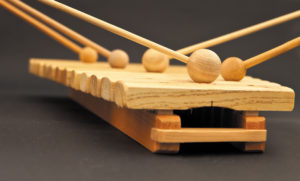Some of the most unique and varied sounds of a percussion section in bands and orchestras come from the melodic mallet instruments. These instruments add exciting sounds and rhythms to the ensemble. They include the popular Xylophone, Marimba, Vibraphone and Glockenspiel. I would venture to say that not too many people know the difference between these instruments.
If you think all musicians in bands and orchestras just sit quietly and play their instruments, watch the percussion section in the back of the band or orchestra. There you will find a beehive of activity. Here are the movers, beaters and shakers of the ensemble. A percussionist must be versatile with the ability to play many percussion instruments: Mallet instruments; Snare Drum; Bass Drum; Timpani; Cymbals and more, while being able to move quickly.
 Audience members frequently comment that it is so much fun to watch the percussion players as they are very animated and move around so much. They must be careful not to get in each other’s way while quickly moving to other instruments.
Audience members frequently comment that it is so much fun to watch the percussion players as they are very animated and move around so much. They must be careful not to get in each other’s way while quickly moving to other instruments.
“My favorite instruments are the mallets,” said Christine Calara, the very talented principal mallet player in the Danville Community Band. “I enjoy playing these instruments because they are unique and also for their soloistic nature.” Calara started out playing piano and this experience transferred well to the mallet instruments, as the two rows on mallet instruments resemble the white and black keys on the piano.
Mallet Instruments
The Xylophone is a percussion instrument consisting of two rows of graduated, tuned bars of hardwood, usually rosewood, that are struck with a stick or mallet that may be either hard or soft. Early instruments were known in Southeast Asia in the 14th Century. They are also used in many non-western cultures, particularly in Africa. They have also attained a high degree of perfection in Javanese orchestras.
Xylophones have a range of three and one half octaves with a tone quality that is dry and wooden without lasting resonance. In the 1830s the instrument became better known and was admitted into Musica Regularis; accepted by symphony orchestras as well as rhythm bands.
The Marimba is a xylophone-like mallet instrument from Africa, primarily the Congo, and also Central and South America. It was introduced to America in the early 16th Century through the slave trade.
It has a number of wooden bars, also usually rosewood, of different sizes and thickness. Located under the bars are tuned, tubular, metal resonators encompassing up to six or seven octaves in larger instruments. The most common instrument is probably four and one half octaves. It is not unusual for the larger Marimbas to be played by several musicians at the same time. It has a warm and mellow tone and is played with rubber or felt-headed mallets. The instrument is considered the national instrument of Guatemala and is very popular in Central America.
The Vibraphone is a percussion instrument originating in the United States around 1920. It is similar to the Marimba but has tuned and graduated metal bars arranged in two rows, again, like a piano keyboard. It is played with padded beaters. It is fitted with electrically driven rotating propellers suspended below the bars causing a vibrato sound—hence the name Vibraphone. A sustaining or damper pedal is part of the instrument. These instruments are usually built with a three octave range although some are larger. The Vibraphone is used frequently in jazz music.
The Glockenspiel is a percussion instrument made up of tuned metal bars, rectangular in shape and arranged in two rows like a piano keyboard. It is played with mallets and has a range of two and one half octaves. This instrument has been used in orchestras since the 18th Century and is of Asiatic origin. They are sometimes known as Orchestra Bells.
A Bell Lyre is a portable Glockenspiel in Lyre form, designed to be used in marching bands. It is held in front of the player and struck with a small metal beater.
Mallet Musicians
Some noted mallet players have become well-known for their musicianship and fame. Lionel Hampton is one of the most famous musicians in the modern era. Hampton, (1908-2002) was an American jazz vibraphonist, percussionist and band leader. His early fame began when he was invited to play with Benny Goodman in his trio that then became a quartet. He also played with Louis Armstrong and Buddy Rich. In 1940 he left the Goodman group to form his own band.
Arthur Lyman (1932-2002) was born in Hawaii and played Vibraphone and Marimba. He excelled in Faux-Polynesian music that became known as “Exotica.” During the 1950s and 60s Lyman was known as the “King of Lounge Music.”
Martin Denny, (1911-2005) a pianist, composer and band leader often used mallet instruments in his music and hired Lyman to play in his combo in 1954. The two men became closely associated in the music world.
The addition of mallet instruments bring exciting sounds and offer different rhythms, melodies and a great range of tones that add to the overall appeal of the music. Not only are the mallet instruments a great addition to the music but they are fun and exciting to play.
Please submit your questions and comments to banddirector01@comcast.net. Visit our website at www.danvilleband.org for up-to-date information about the Danville Community Band.
_______________________________##___________________________________
Leave a Reply